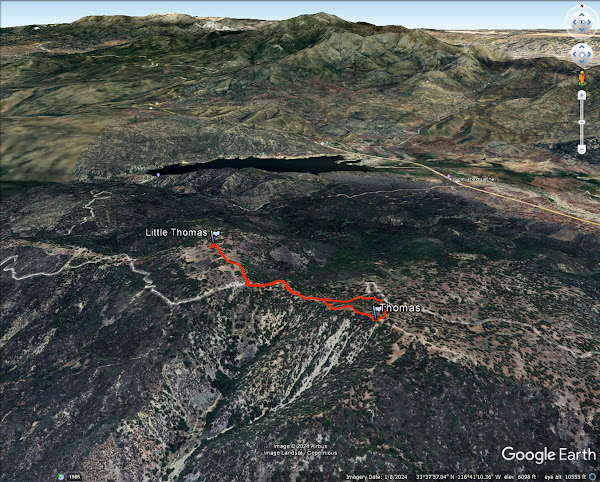Distance: 7.6 miles round trip on trail and cross country
Summit Elevation: 3960' (Indianhead), 2925' (Borrego Point)
Elevation Gain: 4285'
Elevation Gain (in Empire State Buildings): 3.4
Round trip time: 11 hours
Recommended water: 164 oz.
Parking/Fees: $10 State Parks Day Use Fee
Difficulty: Strenuous
My original plan was to climb Spanish Needle in the southern Sierra. But, there was a hazardous wind warning with 35mph gusts. Not ideal for the serious scrambling involved. Instead, Henry Chen and I decided to try a new route on the east ridge of Indianhead (DPS #83, SDC #50) in Anza-Borrego. I had climbed Indianhead twice: the standard DPS route B up Palm Canyon, and also the north ridge (the easiest route), but this would be Henry's first time on the mountain. We started shortly after sunrise around 7:00 AM. I suggested we start on a slope that looked like a better approach to the first bump on the east ridge than the ridge proper. Henry agreed. The first mile was steep, 1700' of up, but presented no serious obstacles. The ridge mellowed as it rose slowly to the unofficial Borrego Point, marked with a small cairn. Then, we faced the first of three challenging bumps.
As we got near the first bump, the slope was at a 50-60 degree angle. Even before we got there, I was planning for a bypass on the north side. When we hit the first class 4 slab, I spotted a gully a couple hundred feet north that looked class 3. Before heading there, I scrambled up a wedge closer to the edge. There were two kinds of rock: whiteish chossy rock and varnished granite that felt solid. The wedge was whiteish rock and crumbly. I decided to downclimb about 100' to reach the gully. Henry climbed one of the red boulders to explore above. The gully was easier and less exposed than the ridge and I made good time. Henry didn't like the continuation, so he dropped down and came up behind me. We made steady progress and reached the second major bump. We got very near the top of the second bump when we hit the next class 4 section. There were two options and both hung over a 300' cliff. This was a harder decision. We were so close to the top, and the downclimb to get around this one was about 400' down. Way, way down. After careful consideration, I decided it was too risky and started the longest downclimb of the day. Periodically, I checked the edge of the gully to see if I could reach it, then kept going lower. Finally, we reached the safer gully. It wasn't clear that we could make it back to the ridge from there. I informed Henry that if we turned back again, I'd have to bail due to lack of water. Fortunately, we made it to the ridge and proceeded to the last major bump. I didn't seriously probe the rocks on top, but looked for downclimb number three on the north side. I dropped through a little portal, down a slab going away from the summit, then skirted the side of the bump to attain the ridge about 200' below the top. Looking back, it might have been possible to go over the last bump without undo risk.
With GPS, I confirmed the bump in front of us was indeed the summit. The south summit started to look familiar and I breathed a deep sigh of relief. The tough terrain had cost us about two hours, but now I was on familiar ground. We signed in and took a well earned respite. We started down the NW ridge, the standard DPS route B. About half way down, I decided the gully looked closer than sticking to the standard route on the ridge. As I started down, I found it too loose, a poor decision. Before I got too far, I decided to angle back up to the ridge. Henry was well behind me but knew what my intent was. It was bad luck that he didn't see me going back up. When I got down to the canyon, I could not see him anywhere. I waited a few minutes then starting yelling for him. I heard him answer and spotted him coming down a nasty dry waterfall in the gully. He had followed my bad decision without seeing my correction. He said there was more class 4 in the gully, a hard way to get off the mountain. We followed a use trail for over a mile to reach the main oasis where the state park trail took over. It was another relief to hit the official trail for an easy finish. The east ridge was fun and challenging, but a one and done for me. It was by far the most difficult of the three routes I've done. I felt remarkably good after a grueling day, but expected to be sore over the next 48 hours.
Would you like to know more...?
See Also:
Indianhead via DPS Route B
Indianhead via North Ridge




































































